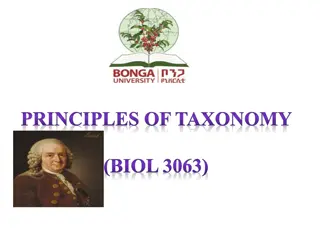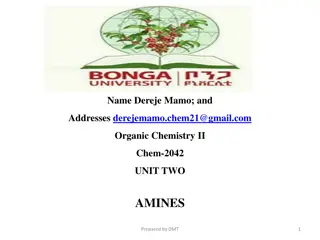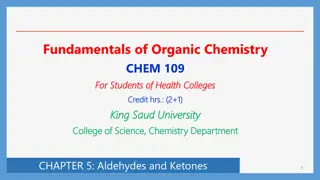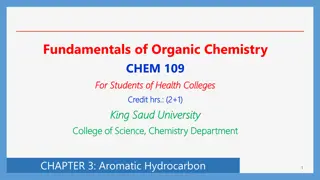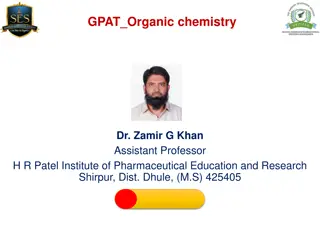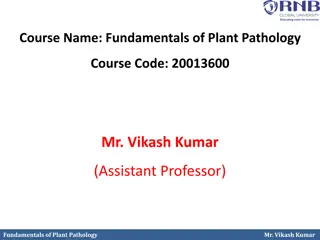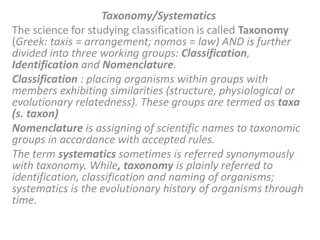Structure and Nomenclature of Ethers
Ethers form an essential class of organic compounds characterized by an oxygen atom linking two organic groups. The chapter delves into the structure, nomenclature, classification, and properties of ethers, exploring symmetrical and unsymmetrical variants. From common to IUPAC nomenclature, the methods of naming ethers are elaborated. Different methods of ether preparation and reactions, including epoxide synthesis and nucleophilic reactions, are also covered in detail.
Download Presentation

Please find below an Image/Link to download the presentation.
The content on the website is provided AS IS for your information and personal use only. It may not be sold, licensed, or shared on other websites without obtaining consent from the author.If you encounter any issues during the download, it is possible that the publisher has removed the file from their server.
You are allowed to download the files provided on this website for personal or commercial use, subject to the condition that they are used lawfully. All files are the property of their respective owners.
The content on the website is provided AS IS for your information and personal use only. It may not be sold, licensed, or shared on other websites without obtaining consent from the author.
E N D
Presentation Transcript
Learning Objectives Learning Objectives Chapter seven discusses the following topics and by the end of this chapter the students will: Know the structure of ethers Know the different methods of naming ethers Know the physical properties of ethers Know the different methods used in preparation of ethers Know the reactions of opened ethers with HX Know the different methods used in synthesis of epoxides Know the reactions of epoxides with different nucleophiles 108 108 Chem Chem 2
Structure and Nomenclature of Ethers Ethers by single bonds to two organic group. The geometry of simple ethers is similar to that of water. General formula: R-O-R or Ar-O-Ar or R-O-Ar Types of Ethers Symmetrical ether: the organic group attached to the oxygen are identical.CH3CH2OCH2CH3 Unsymmetrical ether (Mixed ether) : the two groups are different. CH3OCH2CH3 Structure and Nomenclature of Ethers Ethers are molecules in which an oxygen atom is linked Types of Ethers 108 108 Chem Chem 3
Classification of Ethers Classification of Ethers (I) Aliphatic Ethers (II) Aromatic Ethers 108 Chem 4
Common Nomenclature Common Nomenclature The common names of ethers are derived by naming the alkyl groups bonded to the oxygen then listing them in alphabetical order followed by the word "ether". In Symmetrical ethers write the prefix Di then name of group followed by the word ether. CH3-O-C2H5 Ethyl methyl ether Dimethyl ether CH3-O-CH3 108 108 Chem Chem 5
IUPAC Nomenclature IUPAC Nomenclature The ether functional group does not have a characteristic IUPAC nomenclature suffix, so the ethers are considered as alkoxy (RO- the smaller alkyl group) derivatives of a parent compounds (alkane, or alkene, or alkyne,or alcohol,----) . Names of some common alkoxy groups (RO-): CH3O-- CH3CH2CH2O-- CH2CH3O-- (CH3)2CHO-- (CH3)3CO C6H5O Methoxy n-Propoxy Ethoxy Isopropoxy tert-Butoxy Phenoxy 108 108 Chem Chem 6
CH3 H3C O C6H13 O O Hexyl methyl ether Methoxy hexane3-Methoxy hexane Ethoxy ethane IUPAC Diethyl ether Common H3C CH3 CH3 O O O H3C CH3 Ethyl vinyl ether Ethoxy ethene Divinyl ether Vinyloxyethene 5-Ethoxy-2-heptene O O O CH3 CH3 Diphenyl ether Methyl Phenyl etheranisole Methoxy benzene Propenyloxy benzene Phenoxy benzene 108 Chem 108 Chem 7
Physical Properties of Ether ether is soluble in water, because the Oxygen atom in ether is capable of hydrogen bonding with water molecules. The solubility decreases with increase in the number of carbon atoms. Physical Properties of Ether Ethers are much less soluble in water than alcohols (Because they don t have OH group, So they are not hydrogen bond donors). More water-soluble than hydrocarbons of similar molecular weight (Because they are polar). boiling points of ethers are lower than alcohols because there are no hydrogen bonding between one ether molecule and another. Oxygen is sp3-hybridized 108 108 Chem Chem 8
Preparation of Preparation of Ethers Ethers The Williamson The reaction of a sodium alkoxide RONa or a sodium phenoxide ArONa with an alkyl halide to form an ether. (nucleophilic substitution reaction ) This method is used for preparation for symmetrical and unsymmetrical ethers. The alkoxide or phenoxide is commonly made by adding Na or K to the alcohol or phenol. .. Na+ + The Williamson synthesis synthesis O .... R O R R + NaX R X ether alkyl halide sodium alkoxide 108 108 Chem Chem 9
If a secondary ( 2) or tertiary alkyl halide ( 3) is used, an alkene is the only reaction product and no ether is formed. 108 108 Chem Chem 10
Dehydration of The dehydration of alcohols takes place in the presence of acid catalysts (H2SO4, H3PO4) under controlled temperature. This method is used for preparation for symmetric ethers. R O H H O R + Dehydration of alcohols alcohols H+ R O R + H2O heat 108 108 Chem Chem 11
The dehydration of 2 and 3 alcohol is unsuccessful to get ethers as alkenes are formed easily. 108 Chem 12
Reaction of Ether Cleavage of ethers by hot concentrated acids Reaction of Ether Cleavage of ethers by hot concentrated acids Heat/ H2O R-O-R + H-X R-OH + R-X concentrated Heat/ H2O R-O-R + 2 H-X 2R-X + H2O excess O OH Conc. HI CH3I + H2O/ heat Note: the smaller alkyl group gets converted to the alkyl halide 108 108 Chem Chem 13
If both the alkyl groups are primary or secondary, the smaller alkyl group gets converted to the alkyl halide predominantly. If one of the alkyl group is tertiary, the point of cleavage is such that the tertiary alkyl halide is formed as the major product If two or more equivalents of acid are used further dehydration can occur on formed alcohols which may react further to form a secondmole of alkyl halide. 108 Chem 14
Epoxides Epoxides Epoxides are cyclic ethers in which the ether oxygen is part of a three-membered ring. Epoxides are very reactive (release of ring strain), and are useful intermediates because of their chemical versatility O O O O Common Ethylene oxide Propylene oxide Isobutylene oxide Styrene oxide IUPAC oxirane 2-Methyl oxirane 2,2-dimethyl oxirane 2-Phenyl oxirane 108 108 Chem Chem 15
The simplest and the most important epoxide is ethylene oxide. Dioxane and tetrahydrofuran are used as solvents 108 Chem 16
Preparation of cyclic ethers Preparation of cyclic ethers Ethylene oxide (oxirane; 1,2-epoxyethane) is industrially important as an intermediate Prepared by reaction of ethylene with oxygen at 300 C and silver oxide catalyst 108 108 Chem Chem 17
Preparation of Epoxides Using a a Peroxyacid Peroxyacids (sometimes called peracids) are used to convert alkenes to epoxides. O Preparation of Epoxides Using Peroxyacid O O + R-C-O-O-H + R-C-O-H meta-chloroperoxybenzoic acid (MCPBA) is often used for these epoxidations. 108 Chem 18
Epoxides from Epoxides from Halohydrins Halohydrins Addition of HO-X to an alkene gives a halohydrin Treatment of a halohydrin with base gives an epoxide Intramolecular Williamson ether synthesis 108 Chem 19
Dehydration Dehydration of of dialcohols dialcohols 108 Chem 20
Reaction of Reaction of Epoxides Epoxides Epoxides are easily undergo ring-opening reactions under both acidic and basic conditions. OH OH OH H2N NH3 HO HX/H+ X H2O/H+ O OH O CH3OH/H+ PhOH/H+ H3CO OH i) RMgX ii) H3O+ i) LiAlH4/ dry ether ii) H3O+ R OH OH 108 108 Chem Chem 21
Thank You for your kind attention Thank You for your kind attention ! ! Questions? Questions? 108 108 Chem Chem 22




